Design of a load balancing Objective Function for RPL
Abstract
Routing protocols for Internet of Things (IoT) play a major role in the performance of the network. The standard Routing Protocol for Low-Power and Lossy Networks (RPL) suffers from a number of limitations including congestion of higher-level nodes and unbalanced topology. This paper proposes a novel Objective Function called Load Balanced Minimum Rank with Hysteresis Objective Function (LB_MRHOF), which assigns child nodes to the most suitable parent in the topology. The Objective Function utilizes a weight of the Expected Transmission Count (ETX) and number of children to calculate the Composite ETX and Number of Children (CENOC) which estimates the load on each node. The attained CENOC is used to select the optimum parent for each node in the topology, where nodes with high CENOC are avoided in the parent selection process. The proposed Objective Function has been evaluated under random and hierarchical network topologies. In addition, the evaluation has investigated the influence of the number of nodes by testing for small, medium and large-scale networks. Results have shown that the proposed Objective Function outperforms MRHOF, OF_FUZZY and OF-EC in terms of Packet Delivery Ratio (PDR) and reduces nodal hop-count under all tested scenarios, with no compromise in energy consumption. They have also revealed that the best performance achieved by LB_MRHOF is attained under large-scale networks. The resulting network topology which is formed by the proposed Objective Function has shown improved balance and more depth.
1.Introduction
The emergence of Internet of Things (IoT) has enabled the interaction of heterogeneous devices and technologies to provide a wide range of applications and services [3,40]. The interaction of these power-constrained devices requires accurate design of routing options to maximize network performance and lifetime. Routing plays a vital role in IoT and provides insight of network operation and expected performance. The requirement for developing routing protocols for IoT arises from the fact that the nature of IoT networks does not generally enable full control over the network topology, as sensors may randomly be scattered over the application area. The Routing Protocol for low-power and Lossy networks (RPL) regards as a standard developed by Internet Engineering Task Force (IETF) for Low power devices and Lossy-Networks (LLNs) and constrained objects. RPL is widely used in IoT applications and Wireless Sensor Networks (WSN) [1].
RPL depends on the Objective Function (OF), which relies on one or more metrics. These metrics are used to build the links between disconnected nodes to build the network topology which contains a root node, intermediate and leaf nodes. Data is transmitted through intermediate nodes until reaching the root node, which has been selected by the OF. RPL has two standard OFs: Objective Function Zero (OF0) and Minimum Rank with Hysteresis Objective Function (MRHOF). An OF is distinguished from others according to its quantitative and qualitative metric types. It is easy to switch between different OFs, making RPL a fixable protocol. Furthermore, new OFs can be plugged and work with RPL regardless of its used metrics. Currently, RPL has become an active research area where OFs have been proposed and their performance is compared with standard OFs.
RPL provides great features such as loop prevention, self-healing, energy efficiency and fast topology convergence. Nevertheless, load balancing is considered as an overlooked function in RPL main components. RPL builds up its topology without considering the load distribution between parent nodes. There are a number of sever faults that appear as a consequence of the unbalanced topology, such as, topology congestion and exhaustion of nodes’ energy, resulting in network holes [11,17,43]. In the existing RPL protocol, a node selects its parent regardless of the parent current conditions and ability to accommodate a new child. In other words, in RPL topology construction, a parent node does not have the right to accept or refuse the adoption of a new child. This one-way selection process does not consider the parent node approval which leads to load-unbalanced topologies. Currying out a two-way parent selection process can be implemented by employing a metric calculated at the parent node to inform the child node about the condition of the parent before creating a formal relation.
Based upon the above-mentioned problem, this work proposes a novel OF called Load Balanced Minimum Rank with Hysteresis Objective Function (LB_MRHOF). The main objective is to mitigate the topology congestion and load balancing limitations which exist in the standard OF in RPL. The OF uses the number of children as an indicator of the parent node’s load. The value of this metric is aggregated with a weighted value of the Expected Transmission Count (ETX) of the node to find the Composite ETX and Number of Children (CENOC) metric. A small value of CENOC implies that the node is under-loaded and has higher energy levels, consequently, it is capable of accommodating additional child nodes. In contrast, a node with a high value of CENOC means higher load and lower power, a situation in which it is not preferred to accept additional child nodes for that parent node. When the node attempts to join the topology, it sends a request message to all candidate parents. Each parent checks the number of adopted children at that moment. It also calculates its ETX value then computes CENOC. The node intending to join compares the CENOC values of all candidate parent nodes and selects the most suitable parent (with the minimum CENOC) accordingly. The proposed LB_MRHOF is evaluated and compared to the standard MRHOF, the OF_FUZZY which combines ETX, Latency and remaining power using fuzzy logic, and the OF-EC which combines ETX and energy consumption [19]. The comparison has been carried out in terms of resultant topology, Packet Delivery Ratio (PDR), power consumption and hop-count. In addition, the performance of the proposed OF has been evaluated in random and hierarchical simulation environments. Moreover, the simulation environment uses three network sizes: small, medium and large to investigate the influence of OFs network performance.
The contribution of this work can be summarized as follows:
- The design and implementation of a novel load balancing OF that equally distributes traffic among nodes with respect to energy levels of nodes.
- Enabling the formation of balanced topologies using RPL.
- Investigating the influence of network topology and node density on performance metrics.
- Enhancement of RPL result indicators compared to existing OFs.
The rest of the paper is organized as follows Section 2 explains the RPL background, control messages and objective functions. Section 3 surveys related work. Section 4 shows the proposed LB_MRHOF OF. In Section 5, the simulation environment and parameter values are revealed. Section 6 demonstrates the obtained results and discusses them. Finally, Section 7 provides conclusions and suggests future work.
2.RPL
RPL is a distance vector routing algorithm, that constructs a Destination Oriented Directed Acyclic Graph (DODAG), which includes many nodes and avoids making loops in the topology [3,5,14,40]. RPL supports communication types such as Point-to-Point (P2P) which is the direct communication between two nodes, Multipoint-to-Point (MP2P) through which messages are sent from nodes to the root, and Point-to-Multipoint (P2MP) where messages are sent from the root to the nodes [17,21,41]. The DODAG construction is a tree structure that starts from a node selected to be the root, as shown in Fig. 1. Other nodes select their parent node based on the value of the Objective Function (OF) of the RPL. One or more metrics are utilized to calculate the value of the OF which increases RPL flexibility making it suitable for any application type. RPL has two standard objective functions: Objective Function Zero (OF0), and Minimum Rank with Hysteresis Objective Function (MRHOF) where each one uses different metrics to calculate its OF. The RPL works together with Internet Control Message Protocol version 6 (ICMPv6) protocol to update the network routes by adding new joining nodes as shown in Fig. 2. Moreover, RPL Protocol cooperates with IPv6 over Low Power Wireless Personal Area Network (6LoWPAN) protocol [35].
Fig. 1.
DODAG topology.
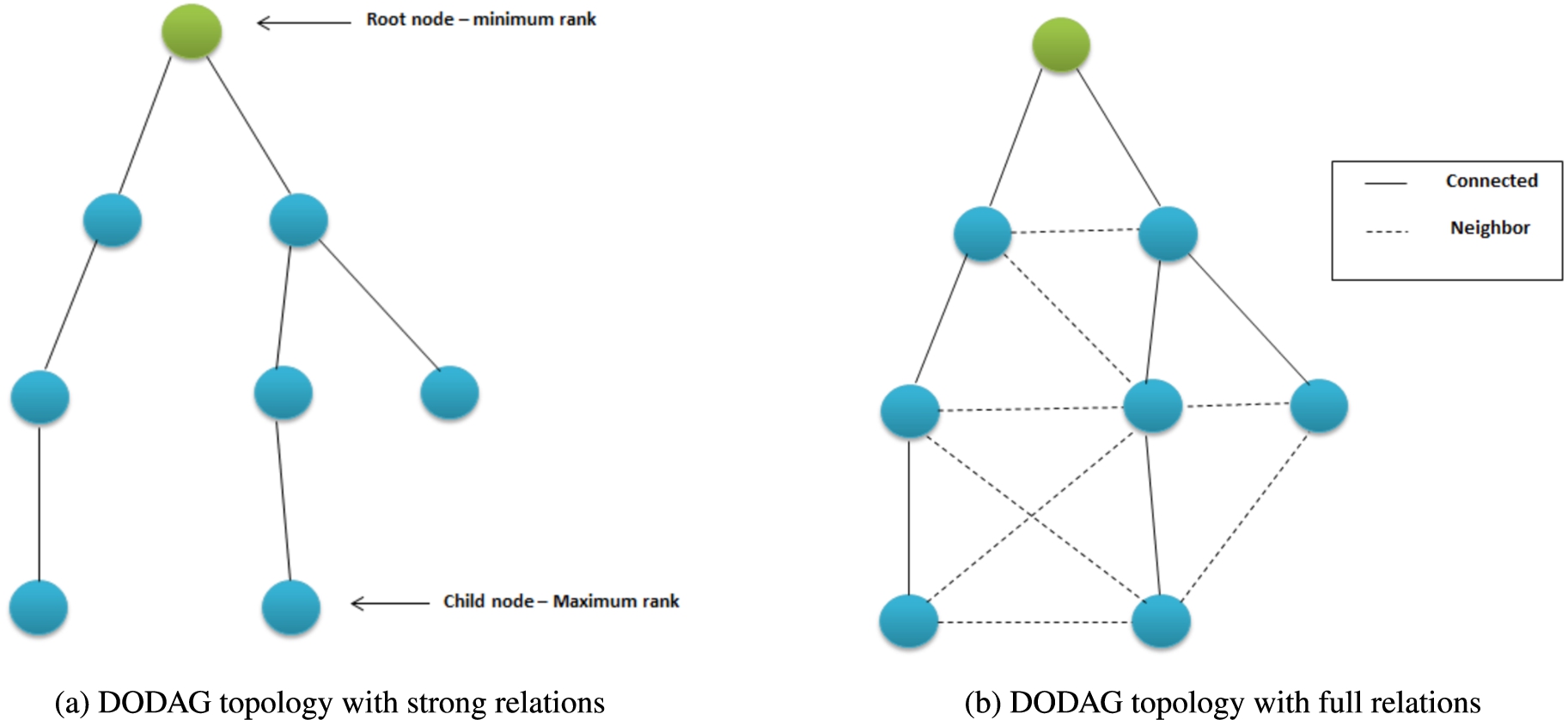
Fig. 2.
ICMPv6 and RPL control messages format.
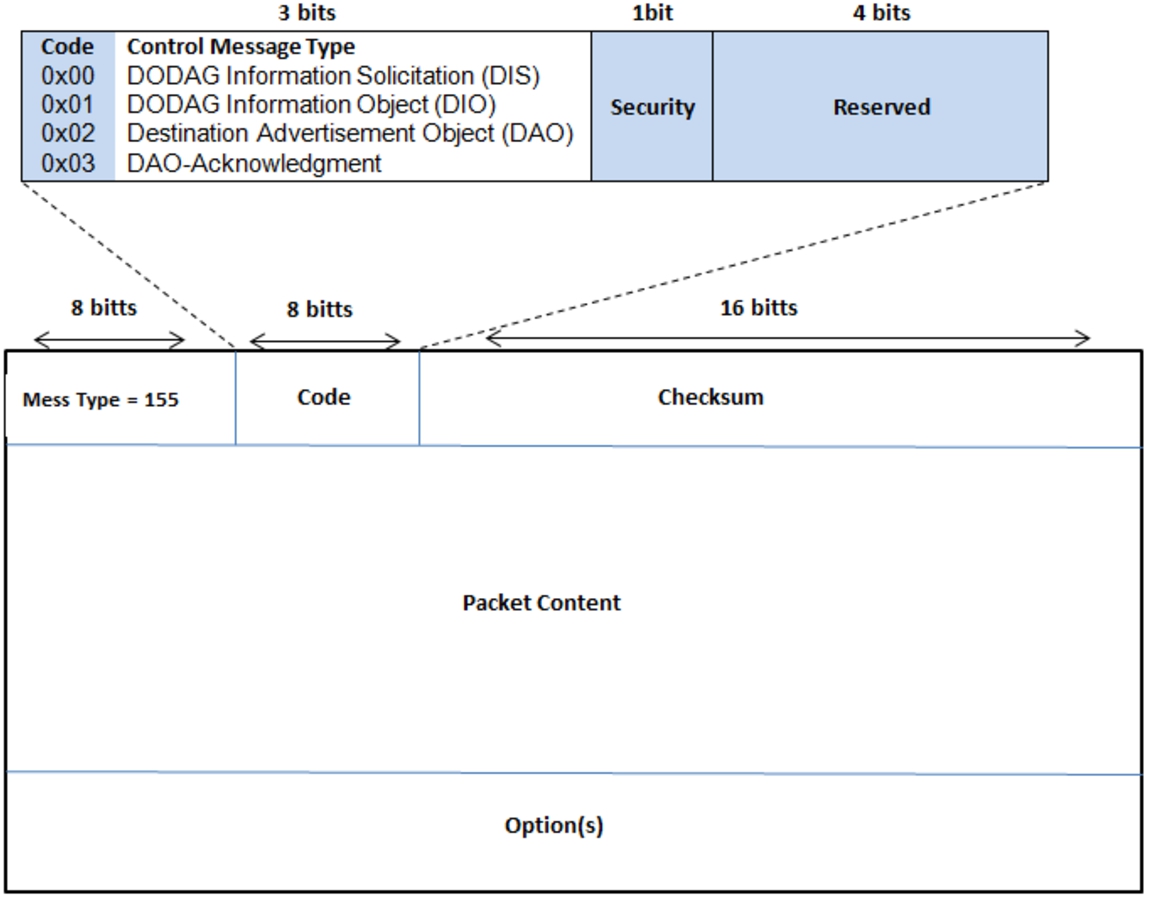
2.1.RPL terms
RPL protocol has several terms which describe its topology structure procedures. These terms are:
DODAG ID: a unique number that remains as long as the root does not change.
DODAG Version: any change of shape in a DODAG during a time is called a DODAG Version.
DODAG Instance: the topology at a certain time.
Ground: connected to Goal (internet).
Flooring: isolated networks or disconnected islands.
Rank: the rank of the root node is 0 and the rank of the children of the root node is 1 and so on. It is used to determine the most appropriate route to the root.
Mode of Operation (MOP): used to encode the type of storing of routing information, e.g. when all nodes store all routing information, MOP is set to ‘storing’, and when the root only stores routing information of the DODAG, MOP is set to ‘non-storing’.
Boarder Router: an internet gateway of the topology used in ground networks.
Candidate Parent: a backup parent in case a node loses its parent.
Metric Container: used to report the metrics along the DODAG.
2.2.RPL control messages
An RPL node has different types of control messages. It sends these messages using ICMPv6 (message type 155) as shown in Fig. 2, with a different code for each message. The main RPL control messages are:
Destination Advertisement Object (DAO): this message is used by all nodes except the root [17]. It is used for advertisement and to unicast messages to candidate parents [28].
DODAG Information Object (DIO): used by the root node to declare itself (and its parameters), and inform the nodes about updates. It contains DODAG ID, RPL Instance ID, Objective Function, metrics, and Rank. DIO is a periodic message used to update nodes’ configuration information [15].
DODAG Information Solicitation (DIS): sent by a new node to its reachable neighbor nodes searching for an existing DODAG.
DAO Acknowledgement (DAO-ACK): reply and acknowledgement of DAO messages.
Table 1 summarises the RPL ICMPv6 control messages.
Table 1
RPL control messages summary
| No | RPL message | Direction | Sent by | Sending time |
| 1 | DIO | Downward | Root | Periodically |
| 2 | DAO | Upward | Child nodes | Event base |
| 3 | DIS | Upward | New nodes | Joint event |
| 4 | DAO-ACK | Downward | DAO receiver | DAO reply |
2.3.Objective function and metrics
RPL has two objective functions by default: MRHOF [10] and OF0 [39]. OF0 uses hop-count as a standard metric and does not use Metric Container, while MRHOF has Metric Container which utilizes Expected Transmission Count (ETX) by default, which supports other energy metrics. Depending on the settings of the OF’s metric, when a node is interested to join the network, the best parent for the node is selected from reachable neighbor nodes that satisfy the parent selection criteria. In other words, the new node selects one of the upper-rank nodes from the set of nearby nodes that are active at that time.
Performance metrics can mainly be classified into [26]:
(1) Node Metrics: such as Energy, Maximum Life Time and Extended RPL Node Trustworthiness.
(2) Link Metrics: including ETX, Delay, Throughput, Link Quality Level and Packet Loss Rate.
(3) Topology Metrics: for instance hop-count.
3.Related work
There are a number of previous studies that proposed using different methods, metrics, and measurements to develop suitable OFs for RPL networks. A clear overview of the RPL protocol and analysis of the most relevant studies was presented in [43]. The paper also explained open research challenges in RPL design as well as pointing out open research issues and future directions. The work in [43] and [23] indicated that RPL does not have an effective mechanism to manage congestion. The random deployment of nodes results in an unbalanced distribution of workload. Lim et al. [23] reviewed numerous studies and have categorized them into three categories: congestion detection, congestion notification and congestion mitigation. In addition, the work has depicted the recent trends of the future researches.
Survey [20] has provided a comprehensive review of RPL background, default OFs (OF0, MRHOF), in addition to link and node metrics and constraints. The survey explained how different approaches combine metrics to implement OFs and classified the approaches into Lexical, Additive and Fuzzy Logic. A statistical analysis of OF related work, RPL limitations and enhancements, and tools (simulations and/or operating systems) used to implement RPL were also explained. Moreover, the survey has presented a beneficial classification of the considered studies and summarized them based upon single and combined metrics. Finally, the survey mentioned the challenges and open issues.
Diniesh et al. [7] has given an overview of RPL, mainly focusing on testing the default OFs (OF0, MRHOF), and how they are used by RPL protocol showing their performance in different scenarios. A number of comparative results were shown.
Considering that RPL control messages are sent periodically, [25] focused on changing of the time interval (by default it is approximately one minute) according to application type. The experiments have been implemented on two existing OF scenarios. Results revealed an increment in PDR and a reduction in the energy consumption induced by increasing RPL time interval. RPL improvements continually moved forward to utilize the node resources in a proper way. The work in [18] proposed D-RPL to improve routing table memory limitations in the nodes at RPL storing mode. It has invented a DAO-NACK message used to stop the spreading of DAO messages all over the network regardless of the memory situation and utilizing the multicast group to reach the root. By reducing the control message overhead the network lifetime and scalability increased.
In [9] the study has focused primarily on DODAG formation techniques. The study has provided a statistical evaluation of the reviewed papers; for instance, nearly 40% of papers utilized single metrics and more than 60% proposed composite metrics. Also, The Contiki OS and Cooja simulator are more popular than other RPL research environments. Moreover, while 18% of researchers use the standard metrics to design OFs, 82% improvised to achieve better results. Qasem et al. [29] has compared the standard OF of MRHOF and OF0 in various network configurations. The results were evaluated in low-density networks, whereas RPL compromises more in high-density networks, finding their work ineffective.
The performance of RPL has been evaluated in [37] for dense and heavily loaded networks. Context-Aware Routing Metric (CARF) utilized both Remaining Power and Queue Utilization of the parent along the path. It shows more load- and power-balanced routes, in addition to lifetime and network stability. A number of studies utilized OF0 and MRHOF objective functions [7,33,34]. Sharma et al. [33] has utilized a single-node static metric with random topology. Four node groups have been subjected to the experiment. The nodes ranged from 40 to 200 node senders with one sink. As parameters, they selected PDR, Overhead, and Power Consumption. Their test results indicated that MRHOF was superior in all instances. Real world experiments were conducted in [34] to determine the best objective function with regard to the power parameter. Results indicated that both OF0 and MRHOF performed equally well, but MRHOF was more energy-efficient. In addition, the number of sink nodes had no effect on power consumption.
The studies in [36] and [44] have focused on utilizing IoT to combat fires around different environments. Using the Cooja simulator with different transmission ranges (50 m and 80 m) of the sensor nodes, the network was analyzed based on measurements including power consumption and duty cycle. Results have shown better energy consumption than the normal energy consumption indicators [36].
Zaatouri et al. [44] have assessed the performance of RPL based on three essential parameters: network density, throughput, and sink localization. It employed the Expected Transmission Count (ETX), Hop-Count (HC) and the energy metric. The results indicated that regardless of the scenarios, the number of nodes influenced the parameters. In terms of PDR and the energy metric, the ETX metric performed well in all scenarios.
Respectively, previous work related to the design of OFs for RPL into single-metric routing, multi-metric routing and load balancing routing are classified.
3.1.Single-metric routing
A single metrics means, that the metric employed in the OF is represented by the only atomic metric. The remaining energy of nodes was first discussed in [16] and [15]. The cost of the path depends on the minimum remaining energy of a node along the path. The study has proposed an OF that avoided cycles by using the rank of the nodes, which is fixed in the DODAG topology, and variable values for other metrics. The node with lower energy is made to be less attractive compared to other nodes, so data is not sent through its path. This can contribute to equalize the energy of nodes by using other more attractive paths, and therefore consuming the energy of nodes with higher energy levels. The study has recommended combining ETX with energy metrics to benefit from the advantages of both.
Instead of calculating the summation or average value of ETX along the path, study [31] has proposed a SIGMA-ETX as an optimization of the OF metric. This has been achieved by adopting the standard deviation of the ETX along the route. The proposed metric has addressed the OF bottleneck problem. ETX metric was combined with the minimum number of hops to improve the default ETX. SIGMA-ETX added a number of fields to the DAO message to obtain ETX values of nodes in the routes. The results have shown good indicators compared to other OFs.
A Neo-hybrid Composite Routing Metric (NCRM) was proposed in [5] improving [31] by adding the energy metric, and the route’s updates were sent to the root via DAO messages. A performance evaluation of the RPL default OFs was demonstrated in [38]. It considered OF0 using the Hop-count metric and MRHOF using ETX and energy metrics. Different tests were applied to different topologies with different simulation times. Results indicated that the change in a transmission range made a clear effect on the RPL DODAG instance building.
An Elaborated cross-Layer RPL OF has been used to achieve energy efficiency in IoT Devices (ELITE). A new metric called Strobe per Packet Ratio (SPR) that works with asynchronous MAC protocols was proposed in [30]. The strobe was used to wake up the node (or parent) from its sleep mode and inform it by a coming packet. It works by reducing the number of strobes along the path, which results in reducing energy consumption and increasing network reliability and overhead.
Using of the standard single metric of OF such as hop-count, ETX, or residual energy affects the network performance positively and/or negatively in different cases. Therefore multiple metrics are combined to maximize positive influences and minimize side effects.
3.2.Multi-metric routing
A number of research studies have been published to develop RPL OF metrics by combining more than one metric to improve network performance. Different studies used different approaches to combine multiple metrics and design OF to serve certain applications. Fuzzy logic and weighted value are the popular methods for metric combination. The combination can involve dual metrics or triple metrics. According to this review, there is no study that uses a fourth metric.
The studies [22] and [4] have aimed to mix metrics to enhance the balance of the topology. The study assumed that if the OF used only ETX metric the network becomes unfair to nodes energy-wise, and if the OF used the energy metric only, then the network will suffer from a higher packet loss ratio. The proposed combination equation merge two different metrics: ETX and energy having a value of 50% weight for both. The energy-oriented metrics improved energy consumption by 8% [22] and 12% [4].
An Energy Efficient and Path Reliability Aware (ERAOF) method was presented in [35], where a composition of link quality and energy metrics were considered. The study [19] uses Fuzzy Logic to combine both the link quality and the node metrics. For link quality, ETX and energy were used and power consumption was considered for node metrics. Results were compared to other ETX-based OFs and other fuzzy logic-based OFs.
Hassan et al. [12] have proposed an OF called RERBDI which is an energy-based study that combined the Residual Energy Ration (RER) of the nodes in the path with Batters Discharge Index (BDI).
The study explained in [32] is concerned with dual metric combination, node and link metrics, energy of the node and the delay of the network. It proposed Energy and Delay Aware Data Aggregation in RPL (EDADA-RPL). It has focused on data aggregation from the child nodes to the root applied on a certain application using Compressed Sensing (CS).
Bandekar et al. [2] have compared physical and simulation experiments on the Zolertia (Z1) motes. The observation has shown changes in power in different applications. The results have shown that the unicast example consumed more energy than the broadcasting example, and that was due to the unicast one-to-one connection establishment requirements.
The study [21] has tested the two standards OFs (MRHOF and OF0), and focused mainly on five metrics: energy, Control Traffic Overhead, lost Packet, hop-count, and ETX. The OFs were tested in three scenarios, a large-scale static network, and two mobile model environments using the Cooja simulator. OF0 has achieved better results than MRHOF in the mobility environment, and MRHOF achieved a better result in the large-scale static nodes.
3.3.Load balanced routing
Load balancing is considered an important yet overlooked function in RPL components. It is employed to organize nodes in the topology in addition to discovery [8]. Many studies apply load balancing in RPL using different approaches including data distribution among multipaths. Load balancing indirectly resolve traffic congestion in the network since it is caused by the network tree being unbalanced. This is achieved by distributing traffic using nodes with less density which facilitates receiving traffic without loss in data packets.
The work in [24] proposed the Load Balance RPL (LB-RPL). It depends on the workload imbalance indicator to proceed with a packet forwarding distribution among a set of parent nodes. The buffer utilization counter was used to monitor the workload that contains a number of packets pushed into the buffer at a certain time.
Parsaei et al. [27] have mentioned that the RPL topology building is ineffective, especially in large-scale networks. A comparison was made between RPL and BL-RPL. Results showed that the proposed OF improved throughput and PDR, but required improvement in the average end-to-end delay.
According to [43], RPL design did not account for effective mechanisms to manage congestion. Random deployment of nodes and heterogeneous traffic patterns in LLNs resulted in an unbalanced distribution of workload. Therefore, nodes consume their power rapidly in hotspot regions. Moreover, sharing the workload can solve the problem of energy holes and lengthen the lifetime of the network.
Study [23] found out that network lifetime is shortened as a result of unbalanced workload distribution leading to uniform energy consumption. Thus load balancing is important for network longevity and reduced congestion. Pancaroglu et al. [26] have concentrated on approaches that were used to solve the RPL load balancing problem. Those that used routing metrics and objective functions to improve load balancing are separated from those that employed heuristic approaches. The first group was further subdivided into two subgroups: those based on standard (well-known) metrics and those based on custom metrics.
According to [13] there are two additional factors that can contribute to load imbalance. The first issue, randomly unbalanced network, occurs when two parent candidates have the same rank value, leading to the random selection of the parent. This practice has the potential to unintentionally cause a load imbalance. The second issue is known as thundering herd, and it occurs when a node with a better transmission path joins an RPL-based network. This might cause a large number of sub-nodes to undergo changes, potentially effecting network stability.
Hadaya et al. [11] have proposed an OF which supports multi-metrics, combining three metrics: ETX, remaining energy, and load. Its goal was to produce a balanced topology and the performance was compared to a number of other OFs. Results have shown promising indicators in PDR and total power consumption. A congestion control and QoS-aware technique called CQARPL was proposed in [17]. The proposed OF controlled the construction of the topology by permitting or preventing a new child from making a link to some parent to organize the topology. The proposed OF used ETX, remaining energy, hop-count, buffer utilization, and child counter. The results have shown promising indicators of the proposed OF in terms of PDR, power consumption, throughput and packet delay compared to other OFs.
4.Proposed load balancing Objective Function
This work proposes an OF that attempts to fix the RPL limitations mentioned in [11,17,43], in particular unbalanced topology and congestion. The proposed Load Balancing Minimum Rank with Hysteresis Objective Function (LB_MRHOF) uses a multi-metric method that is designed by combining the load balanced metrics (a counter of the node’s number of children), the ETX value of parent nodes, and uses the node rank as a constraint. The method combines the load balanced metric and ETX using a weight parameter producing the Composite ETX and Number of Children CENOC metric. The ETX value is generated at the root node, then it is passed down the topology for child nodes to calculate their respective ETX and so on. In contrast, the load value is collected by nodes having the highest ranks (leaf nodes) and passed one level up the topology towards the root. The RPL DAO control message of the ICMPv6 protocol is utilized to collect the load by attaining the flag of the message. The parent node receives DAO messages from child nodes and counts the number of children. The DAO and DAO-ACK message flags are able to inform the parent node about child nodes that have selected them as parent, or have left them and selected a different parent to balance the load. Therefore, a given node calculates the number of children from messages received from lower-level nodes and determines the ETX value from messages passed down from higher-level nodes. This is shown in Fig. 3.
Fig. 3.
LB_MRHOF metrics combination.
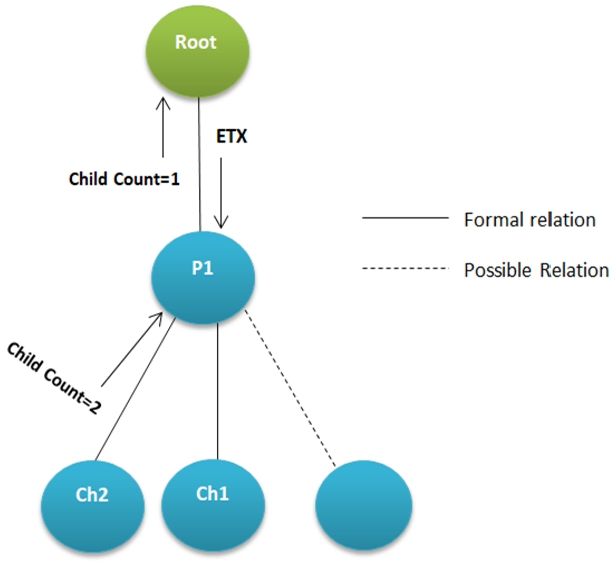
The load indicator CENOC of a node is calculated from the ETX value by applying a flexible weighted parameter (w) in addition to the node’s number of children as illustrated in Equation (3). This equation is calculated for each candidate parent.
The proposed OF uses the minimum aggregation function that prefers lower values of CENOC. A new node that attempts to join the DODAG will decide to connect to a parent node with the minimum CENOC and acceptable network metrics, resulting in the final topology being well-balanced.
This work proposes a Stability Ratio parameter (
Algorithm 1 shows the best parent selection algorithm of LB_MRHOF. the dag refers to the DODAG that contains the two parents. ETX1 and ETX2 are the network metric of parent 1 and parent 2 respectively. rankP1 and rankP2 are the ranks of parent 1 and parent 2 respectively. The algorithm uses Equation (4) at first. The value of
The Objective Function of LB_MRHOF is a minimization equation and is indicated in Equation (5):
Algorithm 1:
LB_MRHOF – best parent selection
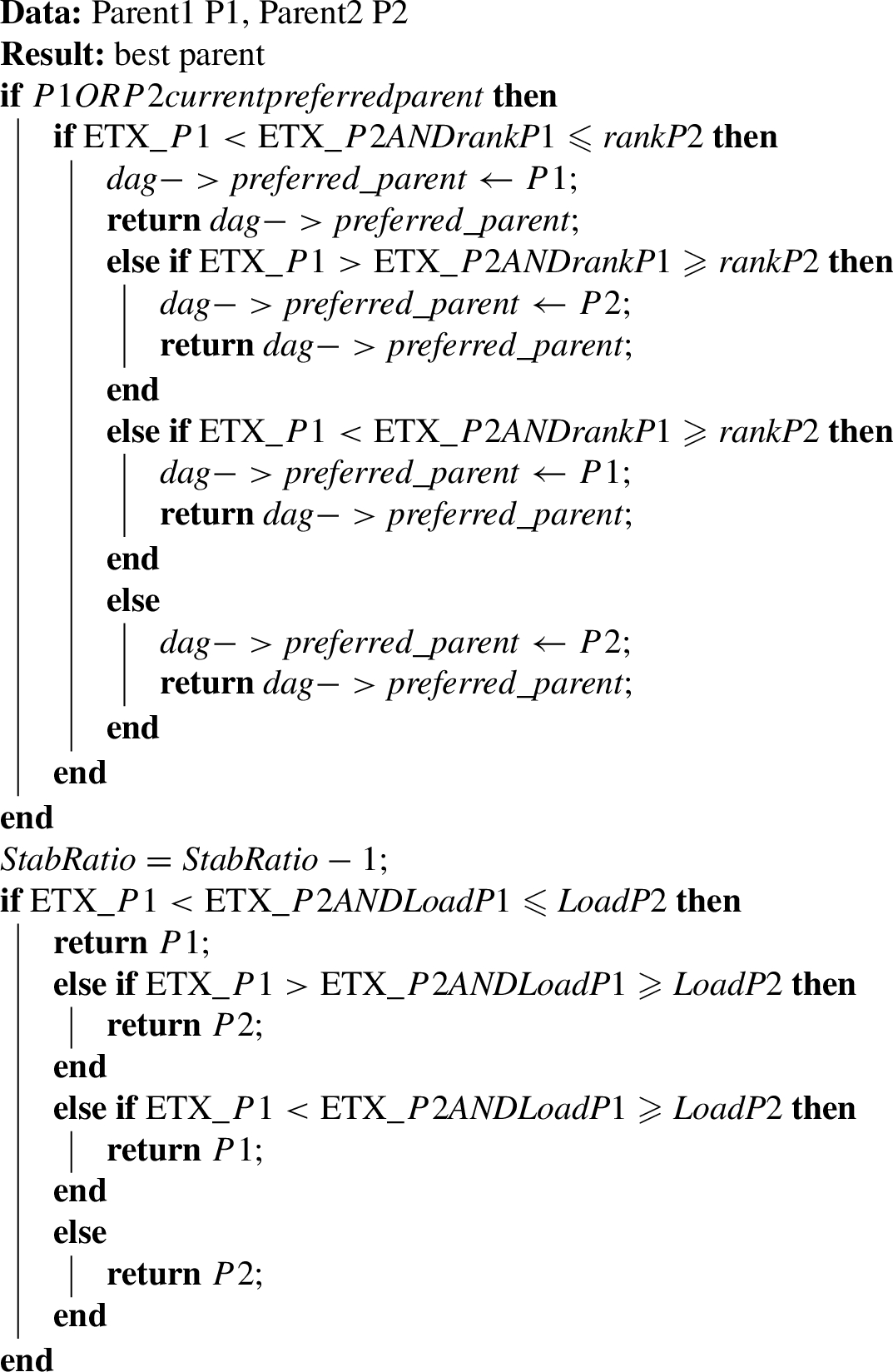
5.Simulation environment and evaluation criteria
This work conducts extensive experiments on RPL considering the trade-off between a balanced topology and improved performance. For benchmarking the proposed LB_MRHOF, the standard MRHOF employing the ETX metric is considered.
5.1.Simulation environment
Two network topologies are considered for this investigation, shown in Fig. 4:
Random Topology: where the nodes are randomly distributed as shown in Fig. 4 (a). In this topology, it is not easy to identify the rank of each node.
Hierarchical Topology: the nodes are structured in a hierarchical form as shown in Fig. 4 (b). The rank of each node can easily be identified in this topology type.
The collect view module of the Cooja simulator was employed to produce the considered network topologies created by both the proposed LB_MRHOF and the standard MRHOF. Moreover, the proposed OF has been assessed under different network sizes. Each topology has beenconsidered with three network sizes where the maximum number of nodes in the network is predefined:
(1) Small-Scale Network: this type represents a network having a limited number of nodes. Each node has a restrained number of candidate parents from which a suitable parent is selected. In general, this type of network experiences low delay and packet loss. A network topology with 20 nodes is considered to exemplify this type (see Fig. 4 (a) and Fig. 4 (b)).
Fig. 4.
Example of (a) random topology and (b) hierarchical topology.

(2) Medium-Scale Network: this type signifies a network with an average number of nodes. The density of the network increases and therefore each node has a relatively larger number of candidate parents compared to small-scale networks. This assessment has been considered as a medium-scale network topology with 40 nodes.
(3) Large-Scale Network: here the topology is made up of a large number of nodes. The possibilities for creating the topology are endless, and reaching an optimum structure is difficult. The problem with this type is that the average hop count of the network is large and this can result in long delays, higher power consumption and a higher risk of packet loss. A network topology with 60 nodes was selected for this type.
All experiments have been carried out using the Cooja simulator under the Contiki Operating System version 3.0. The collect view module has been utilized to extract some of the results. Cooja is a Java-based simulation widely uses in IoT and WSN research [6]. The simulation time was 60 minutes for the three node group sizes. Table 2 shows the parameter values and configurations used in the simulation.
Table 2
The simulation parameters
| No | Simulation parameters | Value and configuration |
| 1 | Operation system | Contiki-3.0 |
| 2 | Number of nodes | 20, 40, and 60 |
| 3 | Area | 100 × 50 m |
| 4 | Topology | Random, hierarchical |
| 5 | Number of hops | 1–14 |
| 6 | Sink nodes number | 1 |
| 7 | Simulation time | 60 minutes |
| 8 | Routing protocol | RPL |
| 9 | Mote type | Zolertia Z1 |
| 10 | RPL mode | RPL storing |
| 11 | Data message rate | 1 msg/minute |
| 12 | Applied RPL example | RPL collect |
| 13 | Weight parameter (w) | 0.1 |
5.2.Evaluation criteria
The following are the criteria regarded as indicators to evaluate the performance of the proposed OF. The most influential metrics on network performance were selected in this work. These metrics are: Packet Delivery Ratio, power consumption, hop-count and balance of the topology. Evaluation results of additional parameters such as conversion time and throughput require further investigation.
5.2.1.Packet delivery ratio
Packet Delivery Ratio (PDR) is calculated by dividing the total received packets at the nodes by the total sent packets, as shown in Equation (6).
5.2.2.Power consumption
The power consumption of the OF is calculated using Equation (7). The equation considers CPU work time, the CPU idle time (Low Power Mode (LPM)), and the radio listen/transmit time.
5.2.3.Hop-count
Hop-count is the total number of intermediate nodes through which data/messages must pass between the source node and the root.
6.LB_MRHOF performance evaluation
The motivation behind LB_MRHOF is to optimally distribute child nodes among the parents taking into account other evaluation criteria, such as Packet Delivery Ratio (PDR), energy consumption, and hop-count. In order to evaluate the performance of the proposed LB_MRHOF, a sensor network topology is set in a 100 m x 50 m area having Zolertia Z1 devices with one sink node. The Cooja simulator is run to deliver messages originating at network nodes to be forwarded to the sink node. The simulation was executed by applying various sets of input values on each OF. The values of outputs have been calculated by finding the average of several runs of each experiment. In order to evaluate the impact of network topology on the performance of the proposed OF, random and hierarchical topologies have been assumed. Moreover, the simulation has been executed with networks having 20, 40 and 60 nodes. The performance of the proposed OF has been compared with the standard MRHOF, OF_FUUZY and OF-EC. The topology has been created and compared under each OF, and results have been obtained for PDR, power consumption and hop-count. The following subsection demonstrates these results.
6.1.Random topology
In a random network environment, nodes are scattered randomly in the application area with no clear rank. The selection of parent nodes does not consider the rank of the nodes. The formation of network topology under this type is considered less complicated. The network topologies created by both the proposed LB_MRHOF and the standard MRHOF are shown in Fig. 5 (a) and Fig. 5 (b), respectively. By observing and comparing the two topologies in Fig. 5 (a) and Fig. 5 (b), the OFs try to construct the topology from reachable neighbor nodes base upon their metrics. The load balancing extra factor in LB_MRHOF arranges and distributes the topology in contrast to the standard MRHOF. In Fig. 5 (b) a number of central hub points appear in the topology, which may lead to network holes over time. The LB_MRHOF OF results in fewer nodes that have no children compared to the standard MRHOF. Figure 6 shows the number of child nodes for each parent under 20, 40 and 60 nodes.
Fig. 5.
Random network topology created by both OFs under 60 nodes.
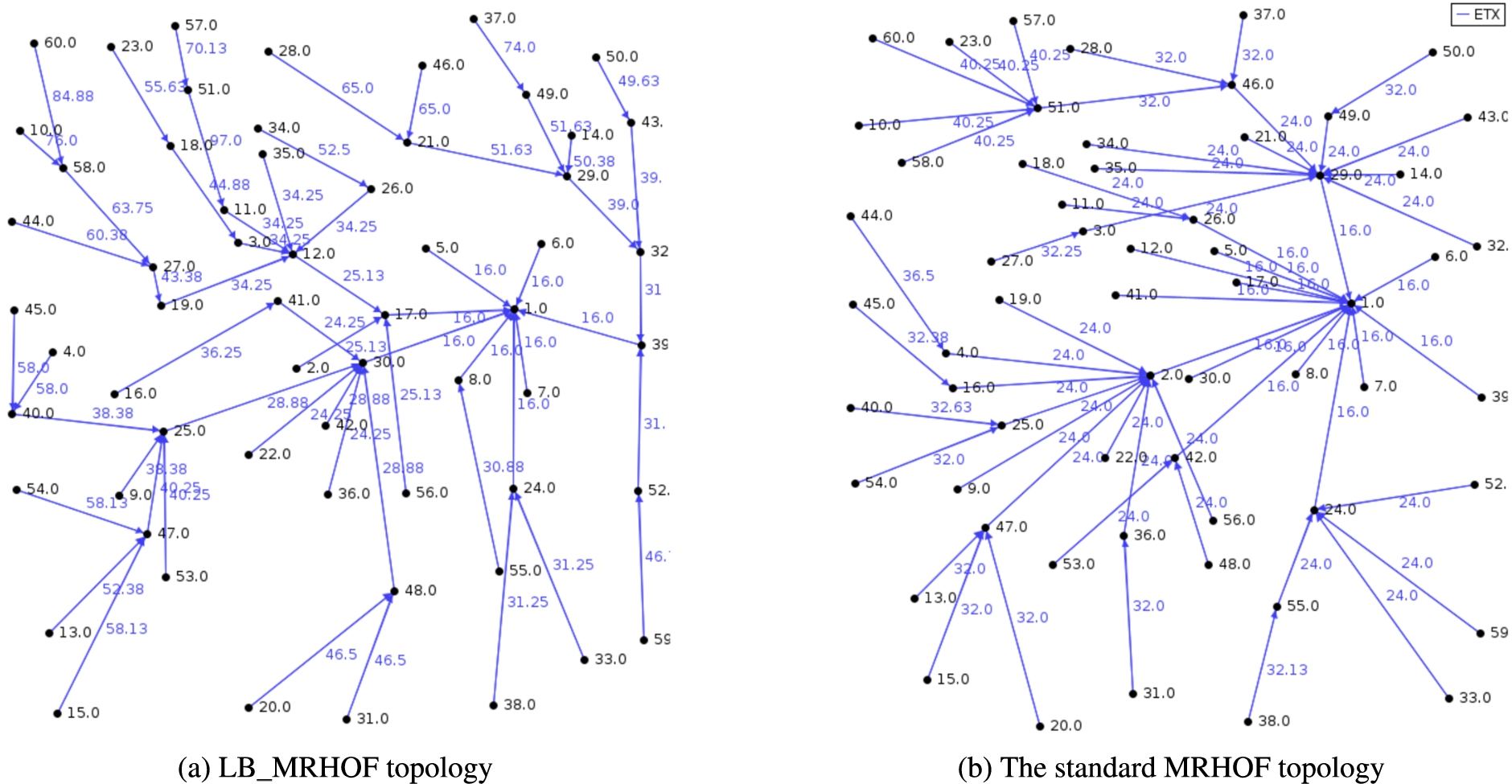
Fig. 6.
The number of child nodes per parent under random topology.

Fig. 7.
Random topology PDR.
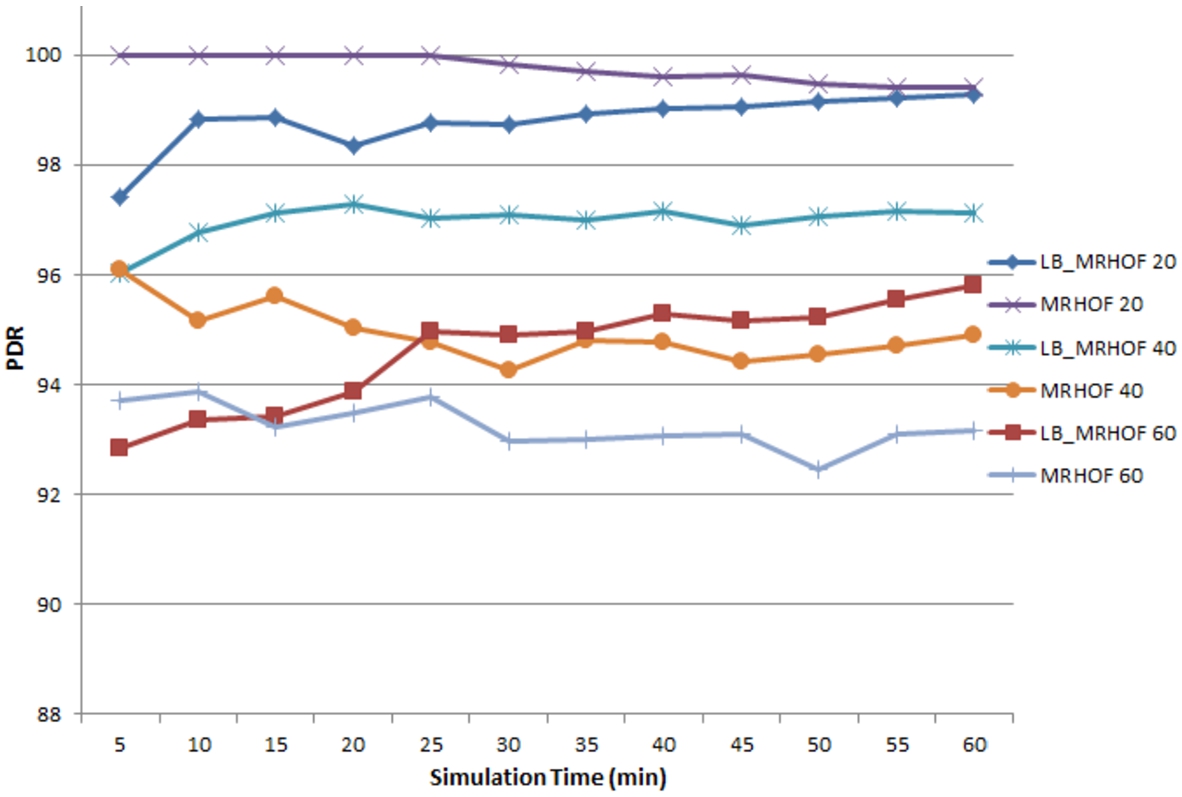
Fig. 8.
Average PDR of the random topology.
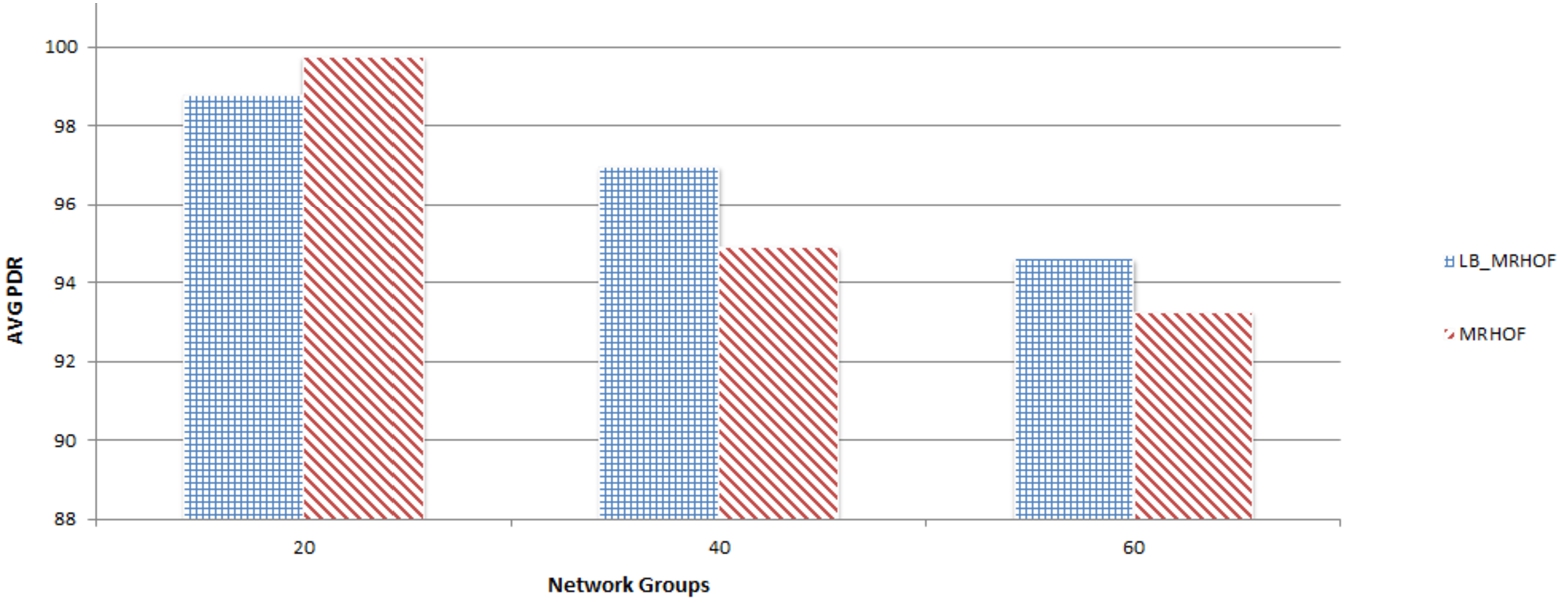
6.1.1.Packet Delivery Ratio (PDR)
In terms of the PDR, LB_MRHOF shows unexpected behavior during the first minutes of the experiments. Low PDR has been observed, and then it has gradually improved, as shown in Fig. 7. This behavior is due to the efforts of the LB_MRHOF to arrange nodes in the topology under low stability conditions. As experiment time progresses, the stability increases resulting in improving PDR. The results have shown that the overall PDR of the network is better under the proposed OF compared to the standard MRHOF, especially under large-scale networks as Fig. 8 and Table 3 prove. The improvement in the PDR in the different node groups is 2.2% and 1.5% for medium and large-scale groups respectively. PDR is less than 1% lower compared to the standard OF in the small-scale group.
6.1.2.Power consumption
The initial simulation time has witnessed notable exchange of messages under the LB_MRHOF, which is due to the topology instability explained in Equation (4). Low stability implies more switching between parents in order to achieve load balancing. This process leads to increased instantaneous power consumption at the beginning of the simulation (first 10 minutes) as can be seen in Fig. 9. Nevertheless, load balancing saves power during the rest of the simulation, which balances the overall power consumption. These savings are expected to increase for longer simulation times, since the momentary power increase occurs only once at the start of the simulation. Load balancing considers the trade-off between reducing power consumption due to fewer children and additional power consumed due to the deeper topology. Power consumed by both OFs is comparable, with marginal savings of 1.7% in power consumption under medium and large-scale networks and negligible increase of 0.46% in small-scale networks. This increase is caused by the additional messages exchange at the start of the experiment. The average power consumption of both OFs is shown in Fig. 10 and Table 4.
Table 3
Random – PDR average for each node group
| Node groups | LB_MRHOF | MRHOF |
| 20 | 99 | 100 |
| 40 | 95 | 95 |
| 60 | 97 | 93 |
| AVG | 97 | 96 |
Fig. 9.
Random topology power consumption.
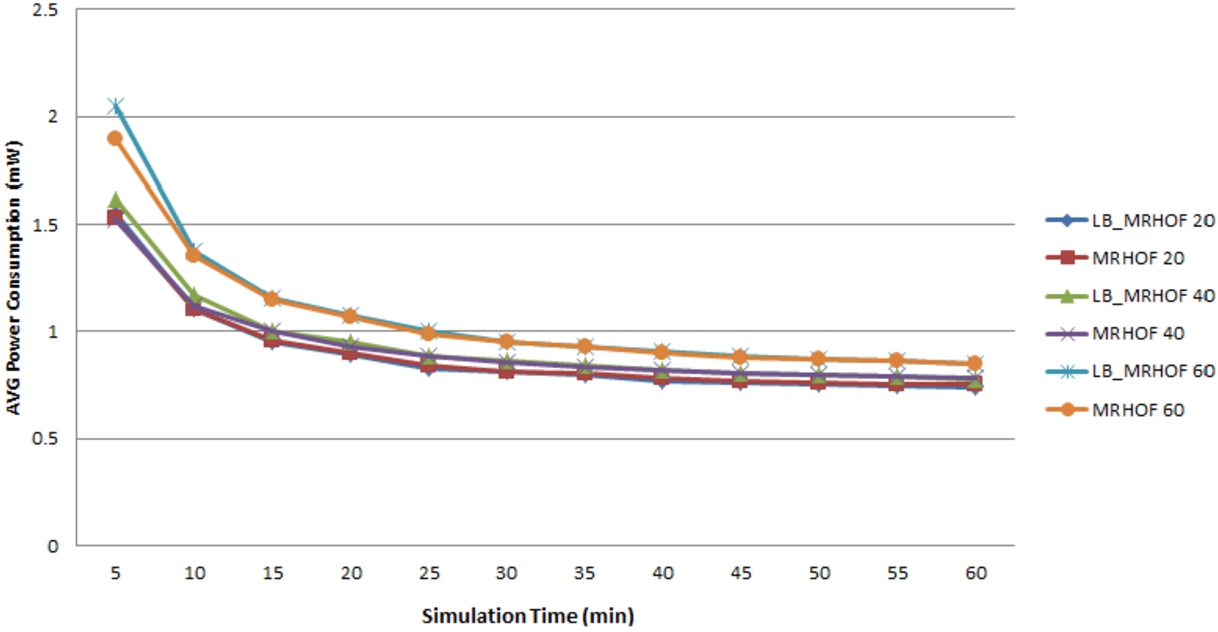
Fig. 10.
Random topology average power consumption.
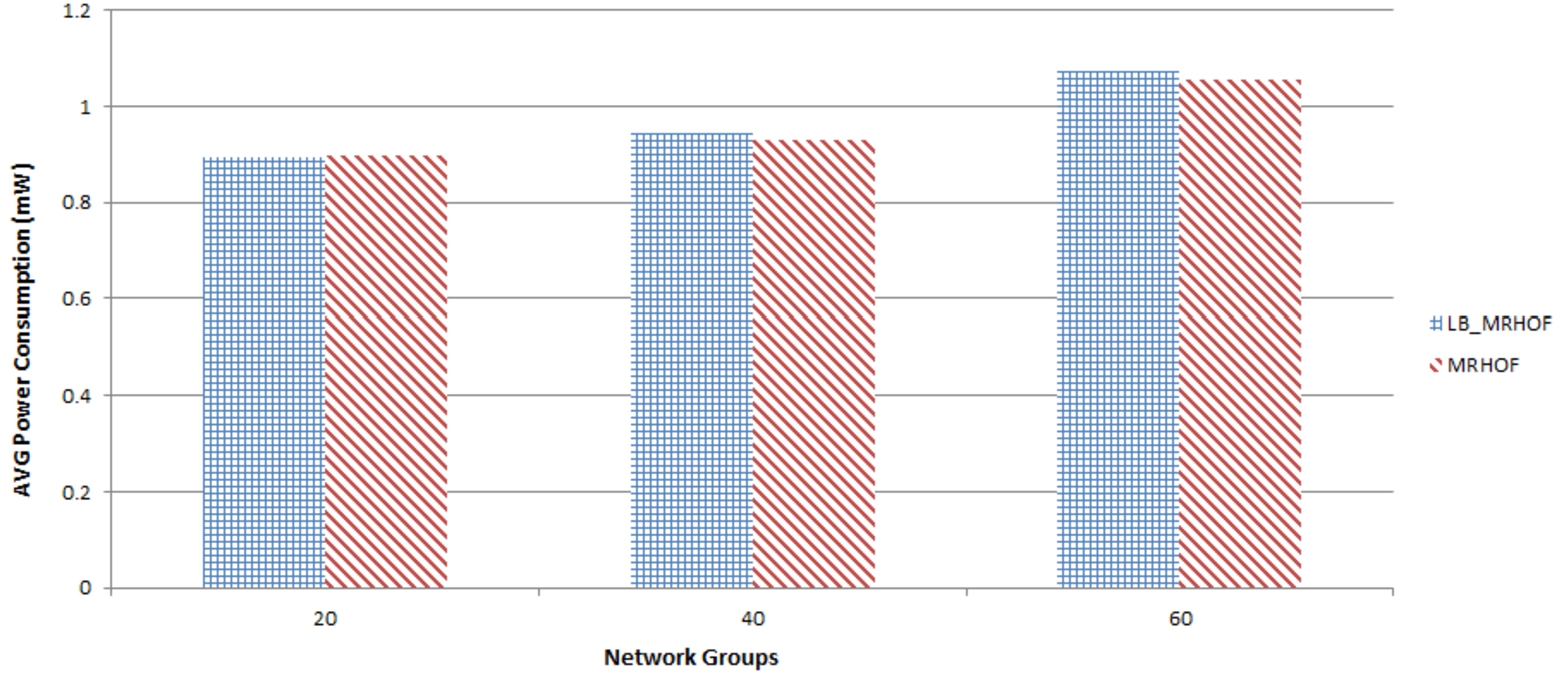
6.1.3.Number of hops
The Hop-count is mainly controlled by the OF configuration. Load balancing arranges the traffic entering nodes and divides it between parents, which has lead to a small increment in the hop-count of the proposed OF as shown in Fig. 11. The OF selects a parent with a lower rank, fewer children and better ETX, resulting in a network topology with more depth. The average hop-count has increased in the proposed OF. The hop count of both the MRHOF and LB_MRHOF are (1.75 and 1.80) for the small-scale network, (3.15 and 3.10) for the medium-scale network, and (3.0 to 2.13) for the large-scale network, respectively.
6.2.Hierarchical topology
In a hierarchical network environment, nodes are easily arranged with respect to rank, and the parent nodes’ selection process considers the rank. Consequently, it is undesired to connect a child to a parent with a higher rank, and connections between nodes of the same rank should be minimized to reduce hop-count. Figure 12 (a) and Fig. 12 (b) demonstrate the hierarchical network topologies that have been created by both the proposed LB_MRHOF and the standard MRHOF, respectively. Observing the two topologies in Fig. 12 (a) and Fig. 12 (b), comparisons can be made. With respect to connections between nodes at the same rank (horizontal connection), in Fig. 12 (b) two horizontal connections have been formed. On other hand, in Fig. 12 (a) no vertical connections are formed, which ensures hop-count minimization. Also, it is clear that the proposed OF has exceeded the standard OF in terms of fair node distribution. Under the standard MRHOF, parent nodes have 1, 2 or 3 child nodes, whereas the proposed LB_MRHOF has resulted in parents having only 1 or 2 children (with the exception of the root).
Table 4
Random – power consumption average under each node group
| Node groups | LB_MRHOF | MRHOF |
| 20 | 0.89 | 0.90 |
| 40 | 0.94 | 0.93 |
| 60 | 1.08 | 1.06 |
| AVG | 0.97 | 0.96 |
Fig. 11.
The frequency of hop-count per node in the random topology.

Fig. 12.
The hierarchical network topology created by both OFs under 20 nodes.
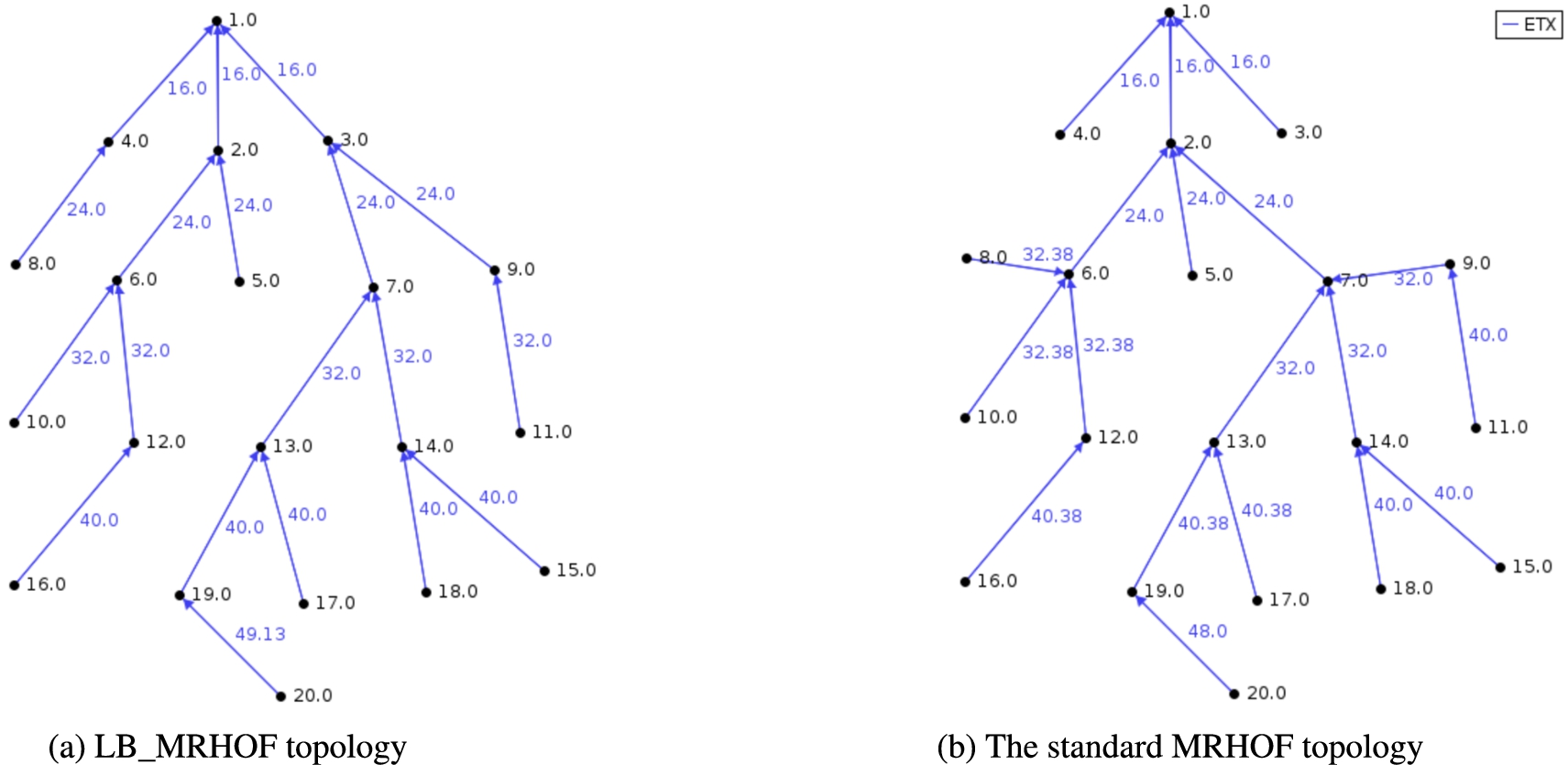
The Load Balancing OF has decreased the number of child nodes per parent, and this increases the depth of the topology. Figure 13 displays the distribution of child nodes among parents for groups of (a) 20 nodes, (b) 40 nodes and (c) 60 nodes for both standard and proposed OFs.
Fig. 13.
The number of child nodes per parent at the hierarchical topology.

6.2.1.Packet Delivery Ratio (PDR)
The proposed LB_MRHOF outperforms the standard MRHOF in terms of PDR. Figure 14 indicates that LB_MRHOF has achieved better PDR compared to MRHOF under all three topology sizes. Improvements in PDR achieved by the proposed OF are 1.8% under 20 nodes, 1.2% under 40 nodes, and 7% in a group of 60 nodes. It is obvious that LB_MRHOF achieves more improvement in PDR in large-scale groups. Figure 15 and Table 5 show the difference between the two OFs for different network sizes.
Fig. 14.
Hierarchical topology PDR.
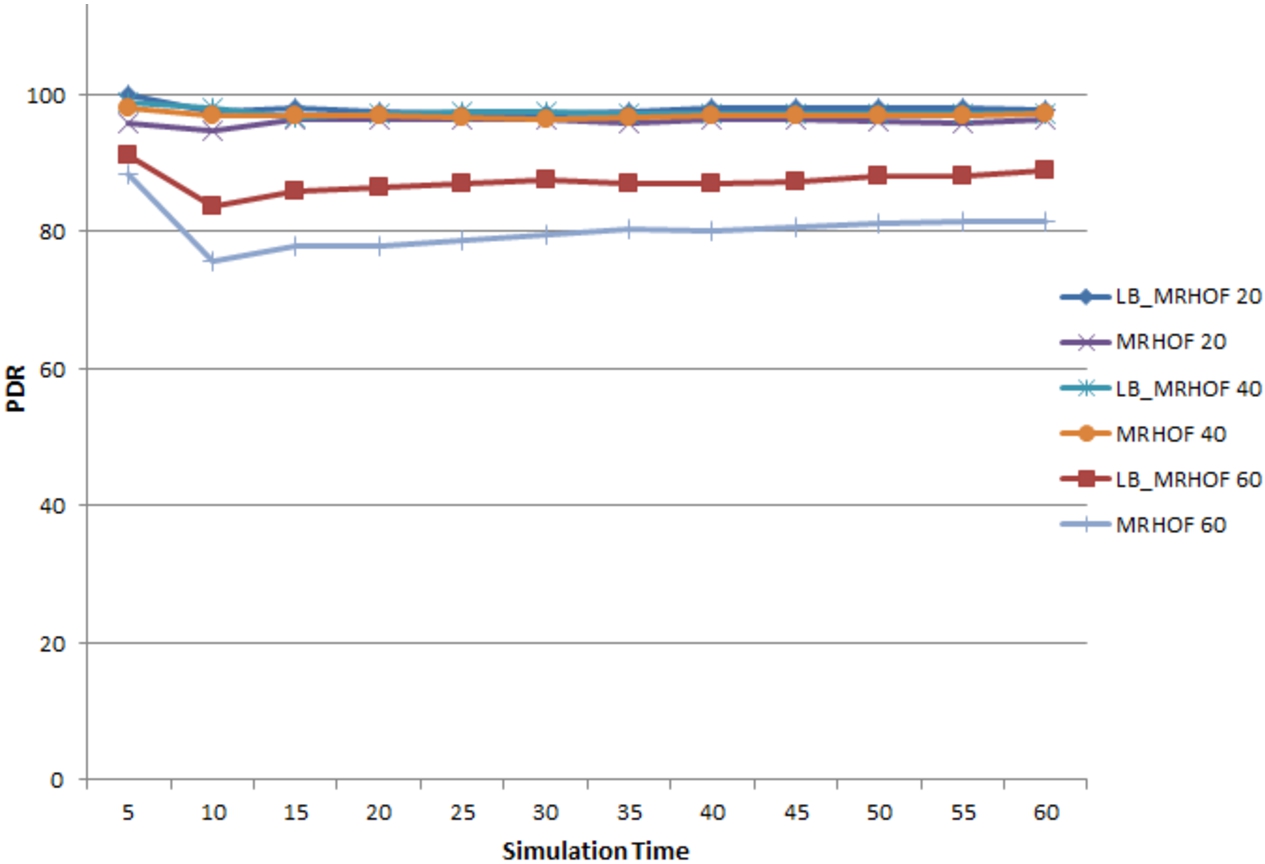
Fig. 15.
Average PDR under hierarchical topology.

Table 5
Hierarchical – PDR average for each node group
| Node groups | LB_MRHOF | MRHOF |
| 20 | 98 | 96 |
| 40 | 97 | 97 |
| 60 | 87 | 80 |
| AVG | 94 | 91 |
6.2.2.Power consumption
Similar to the random topology, under a hierarchical topology, the power consumption at the start of the simulation is high due to message exchange during topology instability. The proposed OF has successfully balanced load amongst topology nodes without compromising power consumption. Figure 16 shows the power consumption of a hierarchical topology for group sizes of 20, 40 and 60 nodes. Figure 17 and Table 6 show the average power consumption under (a) 20, (b) 40 and (c) 60 nodes. The maximum difference in average power consumption between the two OFs is 2.5%.
Fig. 16.
Hierarchical topology power consumption.

Fig. 17.
Hierarchical topology average power consumption.
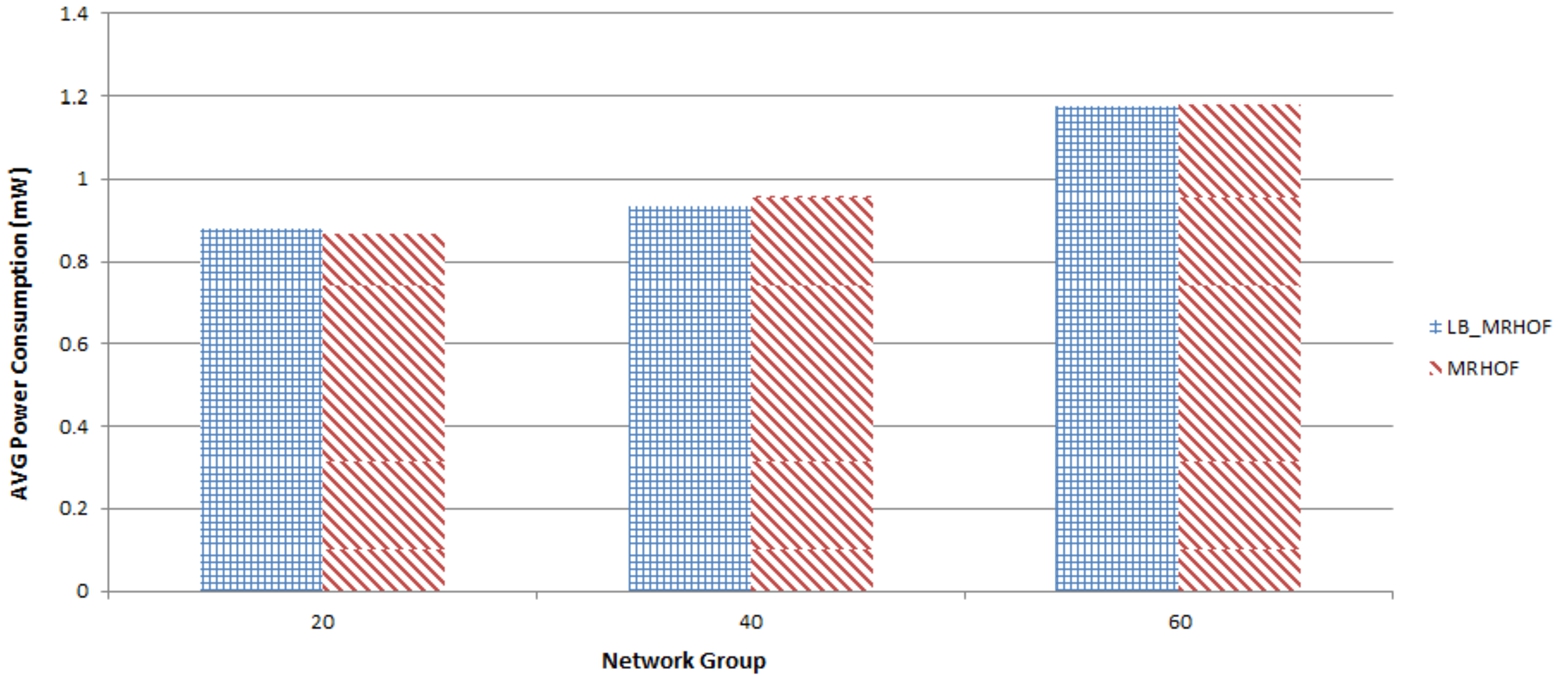
Table 6
Hierarchical – power consumption average under each node group
| Node groups | LB_MRHOF | MRHOF |
| 20 | 0.88 | 0.87 |
| 40 | 0.94 | 0.96 |
| 60 | 1.18 | 1.18 |
| AVG | 1.00 | 1.00 |
6.2.3.Number of hops
The hop-count relates directly to the depth of the constructed topology. Even though load balancing focuses on well-optimizing the number of children per node, apparently this fact does not negatively impact the resultant hop-count. Figure 18 shows the number of hops under (a) 20, (b) 40 and (c) 60 nodes. Figure 18 demonstrates that the proposed LB_MRHOF works well on the large-scale topology, providing a smaller maximum hop-count (9) compared to the standard MRHOF (11). This can be explained by the same-rank connections made by the standard MRHOF as shown in Fig. 12 (b). Under MRHOF, in some situations the node chooses its left or right neighbor as a parent, instead of choosing from the set of upper-level nodes which are on the path towards the root, resulting in increasing the hop-count. The average hop-count of MRHOF and LB_MRHOF is (2.80 and 2.65) in the small-scale network, (2.68 and 2.68) in the medium-scale network, and (5.63 and 4.34) in the large-scale network, respectively.
Fig. 18.
The frequency of hop-count per node in the hierarchical topology.

Fig. 19.
Average PDR of the four OFs.
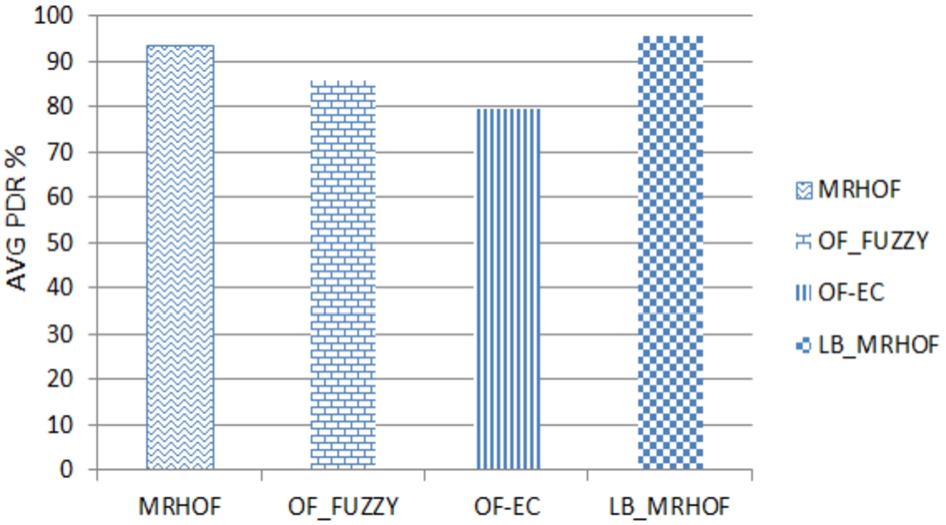
6.3.Comparison with previously proposed methods
To fully evaluate the performance of the proposed OF, the attained results of LB_MRHOF have been compared with MRHOF, OF_FUZZY, and OF-EC. OF_FUZZY and OF-EC both use fuzzy logic to combine their metrics. The OF_FUZZY is an objective function which combines ETX, latency and remaining power, while the OF-EC is an objective function which combines ETX and energy consumption [19]. The PDR of the four OFs has been compared and shown in Fig. 19 and Table 7. PDR results show that the proposed LB_MRHOF has achieved the highest PDR among evaluated OFs with an improvement of 2%, 10%, and 17% under MRHOF, OF_FUZZY and OF-EC, respectively. Also, the power consumption comparison results are shown in Fig. 20 and Table 8. MRHOF has consumed similar power compared to LB_MRHOF and (33.3% and 47.3%) less power compared to OF_FUZZY and OF-EC, respectively. Comparison results have proven the improvement of the proposed OF over existing OFs.
Table 7
Average PDR for all OFs
| No | Objective function | PDR |
| 1 | MRHOF | 94 |
| 2 | OF_FUZZY | 80 |
| 3 | OF-EC | 79 |
| 4 | LB_MRHOF | 96 |
Fig. 20.
Average power consumption of the four OFs.
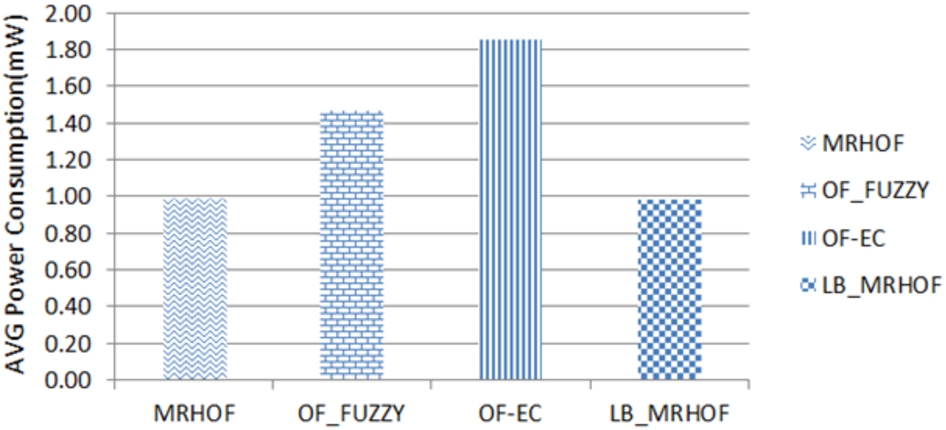
The average PDR and power consumption have been calculated for the four OFs and shown in Table 7 and Table 8, respectively.
Table 8
Average power consumption for all OFs
| No | Objective function | Power consumption AVG |
| 1 | MRHOF | 0.98 |
| 2 | OF_FUZZY | 1.47 |
| 3 | OF-EC | 1.86 |
| 4 | LB_MRHOF | 0.98 |
It is worth mentioning that the investigation carried out in this work demonstrates results for the most significant metrics that directly influence network performance. There is a number of other metrics that also could be evaluated for further analysis of the proposed OF. These metrics include throughput, packet loss and delay. Nevertheless, it is possible to estimate the expected impact of the proposed OF on some of these metrics. For instance, network delay is strongly related to the number of hops and congestion at intermediate nodes. Attained results have shown that the proposed LB_MRHOF has reduced hop count under random and hierarchical topologies. In addition, the fair distribution of load amongst parent nodes ensures minimum congestion at intermediate nodes. As a result, it is apparent that the proposed OF is expected to reduce the average and overall network delay compared to the standard MRHOF. Furthermore, packet loss can be estimated from PDR, since PDR signifies successful packet delivery. Accordingly, and since LB_MRHOF has been able to increase PDR under random and hierarchical topology (except random low scale networks), it is safe to predict that the proposed OF is likely to result in less packet loss compared to the standard MRHOF.
Evaluation results have proven that the proposed LB_MRHOF outperforms existing OFs in major performance evaluation parameters. Nevertheless, the proposed OF suffers from increased computational overhead at the start of simulation due to frequent parent switching to ensure load balancing. This initial topology instability implies higher power consumption. Reducing the number of candidate parents can consequently improve the stability of the topology which regulates computational overhead. However, this compromises load balancing, which negatively impacts other parameters and LB_MRHOF will behave similar to MRHOF.
7.Conclusions and future work
This work has proposed a load balancing OF to overcome RPL main limitations including the unbalanced topology and congestion around nodes closest to the root. The proposed LB_MRHOF constructs the RPL topology considering the distribution of nodes among their parents. The selection process of the best parent is based on the load-based Composite ETX and Number of Children (CENOC) metric which is calculated at parent nodes. The evaluation has considered random and hierarchical network topologies and has investigated the influence of the number of nodes. The proposed OF has been evaluated using a number of parameters including PDR, power consumption and hop count. Attained results have proven that the proposed OF was able to reduce the number of children per node and average hop count, compared to the standard MRHOF. The proposed OF has significantly outperformed OF_FUZZY and OF-EC in PDR and power consumption. The load balancing process has resulted in additional message exchange at the start of the simulation. This improves the overall performance of the OF with no compromise on overall power consumption. Results have also revealed that the proposed OF constructs a well-balanced topology and performs better under large-scale networks. Future work intends to evaluate the LB_MRHOF considering performance metrics which have not been tested including delay, throughput and packet loss. It also plans to investigate the influence of the weight parameter (w) of the CENOC metric on performance evaluation.
Conflict of interest
The authors have no conflict of interest to report.
References
[1] | E. Aljarrah, M.B. Yassein and S. Aljawarneh, Routing protocol of low-power and lossy network: Survey and open issues, in: 2016 International Conference on Engineering & MIS (ICEMIS), IEEE, (2016) , pp. 1–6. |
[2] | A. Bandekar, A. Kotian and A.Y. Javaid, Comparative analysis of simulation and real-world energy consumption for battery-life estimation of low-power iot (Internet of Things) deployment in varying environmental conditions using zolertia z1 motes, in: International Conference on Sensor Systems and Software, Springer, (2016) , pp. 137–148. |
[3] | H. Bouzebiba and M. Lehsaini, Freebw-rpl: A new rpl protocol objective function for Internet of multimedia things, Wireless Personal Communications 112: (2) ((2020) ), 1003–1023. doi:10.1007/s11277-020-07088-6. |
[4] | L.-H. Chang, T.-H. Lee, S.-J. Chen and C.-Y. Liao, Energy-efficient oriented routing algorithm in wireless sensor networks, in: 2013 IEEE International Conference on Systems, Man, and Cybernetics, IEEE, (2013) , pp. 3813–3818. ISBN 1479906522. doi:10.1109/SMC.2013.651. |
[5] | A.S.J. Charles and K. Palanisamy, Neo-hybrid composite routing metric for RPL, Procedia Computer Science 171: ((2020) ), 1819–1828. doi:10.1016/j.procs.2020.04.195. |
[6] | Deepanker, Collect view using Cooja simulator, (2016) , https://anrg.usc.edu/contiki/index.php/Collect_ViewUsing_Cooja_Simulator. |
[7] | V.C. Diniesh, G. Murugesan, M.J.A. Jude, A. Harshini, S. Bhavataarani and R.G. Krishnan, Impacts of objective function on rpl-routing protocol: A survey, in: 2021 Sixth International Conference on Wireless Communications, Signal Processing and Networking (WiSPNET), IEEE, (2021) , pp. 251–255. ISBN 1665440864. doi:10.1109/WiSPNET51692.2021.9419400. |
[8] | M.Y. Elmahi, N.I. Osman and H.S. Hamza, Resource discovery classification for Internet of Things: A survey, International Journal of Digital Information and Wireless Communications 10: (3) ((2020) ), 35–50. doi:10.17781/P002661. |
[9] | S. Garg, D. Mehrotra and S. Pandey, A study on RPL protocol with respect to DODAG formation using objective function, in: Soft Computing: Theories and Applications, Springer, (2022) , pp. 633–644. doi:10.1007/978-981-16-1740-9_52. |
[10] | O. Gnawali and P. Levis, The minimum rank with hysteresis objective function, Technical report, (2012) . ISBN 2070-1721. |
[11] | N.N. Hadaya and S.A. Alabady, Proposed RPL routing protocol in the IoT applications, Concurrency and Computation: Practice and Experience 34: (10) ((2022) ), e6805. doi:10.1002/cpe.6805. |
[12] | A. Hassan, S. Alshomrani, A. Altalhi and S. Ahsan, Improved routing metrics for energy constrained interconnected devices in low-power and lossy networks, Journal of communications and networks 18: (3) ((2016) ), 327–332. doi:10.1109/JCN.2016.000048. |
[13] | J. Hou, R. Jadhav and Z. Luo, Optimization of parent-node selection in RPL-based networks, Internet Engineering Task Force (IETF) draft 1: ((2017) ). |
[14] | S.V. Johansen, Node energy consumption variations with WirelessHART and RPL in a wireless sensor network, (2018) . |
[15] | P.O. Kamgueu, E. Nataf, T.N. Djotio and O. Festor, Energy-based metric for the routing protocol in low-power and lossy network, in: SENSORNETS, (2013) , pp. 145–148. |
[16] | P.O. Kamgueu, E. Nataf, T.D. Ndié and O. Festor, Energy-based routing metric for RPL, Inria ((2013) ). |
[17] | F. Kaviani and M. Soltanaghaei, CQARPL: Congestion and QoS-aware RPL for IoT applications under heavy traffic, The Journal of Supercomputing ((2022) ), 1–31. |
[18] | C. Kiraly, T. Istomin, O. Iova and G.P. Picco, D-RPL: Overcoming memory limitations in RPL point-to-multipoint routing, in: 2015 IEEE 40th Conference on Local Computer Networks (LCN), IEEE, (2015) , pp. 157–160. ISBN 1467367702. doi:10.1109/LCN.2015.7366295. |
[19] | H. Lamaazi and N. Benamar, RPL enhancement using a new objective function based on combined metrics, in: 2017 13th International Wireless Communications and Mobile Computing Conference (IWCMC), IEEE, (2017) , pp. 1459–1464. ISBN 1509043721. doi:10.1109/IWCMC.2017.7986499. |
[20] | H. Lamaazi and N. Benamar, A comprehensive survey on enhancements and limitations of the RPL protocol: A focus on the objective function, Ad Hoc Networks 96: ((2020) ), 102001. doi:10.1016/j.adhoc.2019.102001. |
[21] | H. Lamaazi, N. Benamar and A.J. Jara, Study of the impact of designed objective function on the RPL-based routing protocol, in: International Symposium on Ubiquitous Networking, Springer, (2016) , pp. 67–80. |
[22] | C.-Y. Liao, L.-H. Chang, T.-H. Lee and S.-J. Chen, An energy-efficiency-oriented routing algorithm over RPL, inf cyut edu tw, (2013) . |
[23] | C. Lim, A survey on congestion control for RPL-based wireless sensor networks, Sensors 19: (11) ((2019) ), 2567. |
[24] | X. Liu, J. Guo, G. Bhatti, P. Orlik and K. Parsons, Load balanced routing for low power and lossy networks, in: 2013 IEEE Wireless Communications and Networking Conference (WCNC), IEEE, (2013) , pp. 2238–2243. ISBN 1467359394. |
[25] | W. Mardini, S. Aljawarneh, A. Al-Abdi and H. Taamneh, Performance evaluation of RPL objective functions for different sending intervals, in: 2018 6th International Symposium on Digital Forensic and Security (ISDFS), IEEE, (2018) , pp. 1–6. ISBN 153863449X. |
[26] | D. Pancaroglu and S. Sen, Load balancing for RPL-based Internet of Things: A review, Ad Hoc Networks 116: ((2021) ), 102491. doi:10.1016/j.adhoc.2021.102491. |
[27] | M.R. Parsaei, A.R. Parnian, S.M. Rostami and R. Javidan, RPL load balancing in Internet of Things, IIUM Engineering Journal 18: (2) ((2017) ), 137–150. doi:10.31436/iiumej.v18i2.702. |
[28] | M. Qasem, Load balancing and context aware enhancements for RPL routed Internet of Things, Edinburgh Napier University, (2018) . |
[29] | M. Qasem, H. Altawssi, M.B. Yassien and A. Al-Dubai, Performance evaluation of RPL objective functions, in: 2015 IEEE International Conference on Computer and Information Technology; Ubiquitous Computing and Communications; Dependable, Autonomic and Secure Computing; Pervasive Intelligence and Computing, IEEE, (2015) , pp. 1606–1613. ISBN 1509001549. doi:10.1109/CIT/IUCC/DASC/PICOM.2015.242. |
[30] | B. Safaei, A.M.H. Monazzah and A. Ejlali, ELITE: An elaborated cross-layer RPL objective function to achieve energy efficiency in Internet-of-Things devices, IEEE Internet of Things Journal 8: (2) ((2020) ), 1169–1182. doi:10.1109/JIOT.2020.3011968. |
[31] | P. Sanmartin, A. Rojas, L. Fernandez, K. Avila, D. Jabba and S. Valle, Sigma routing metric for RPL protocol, Sensors 18: (4) ((2018) ), 1277. doi:10.3390/s18041277. |
[32] | S. Sennan, S. Balasubramaniyam, A.K. Luhach, S. Ramasubbareddy, N. Chilamkurti and Y. Nam, Energy and delay aware data aggregation in routing protocol for Internet of Things, Sensors 19: (24) ((2019) ), 5486. |
[33] | R. Sharma and T. Jayavignesh, Quantitative analysis and evaluation of RPL with various objective functions for 6LoWPAN, Indian Journal of Science and Technology 8: (19) ((2015) ), 1. doi:10.17485/ijst/2016/v9i16/92574. |
[34] | S.P. Shetty and U.K.K. Shenoy, Performance of RPL objective functions using FIT IoT lab, in: International Conference on Innovative Computing and Communications, Springer, (2021) , pp. 623–630. doi:10.1007/978-981-15-5148-2_55. |
[35] | N. Sousa, J.V.V. Sobral, J.J.P.C. Rodrigues, R.A.L. Rabêlo and P. Solic, ERAOF: A new RPL protocol objective function for Internet of Things applications, in: 2017 2nd International Multidisciplinary Conference on Computer and Energy Science (SpliTech), IEEE, (2017) , pp. 1–5. ISBN 9532900713. |
[36] | S. Srividhya and S. Sankaranarayanan, IoT enabled energy efficient routing in forest fire, in: ICCCE 2021, Springer, (2022) , pp. 29–35. doi:10.1007/978-981-16-7985-8_4. |
[37] | S. Taghizadeh, H. Bobarshad and H. Elbiaze, CLRPL: Context-aware and load balancing RPL for IoT networks under heavy and highly dynamic load, IEEE access 6: ((2018) ), 23277–23291. doi:10.1109/ACCESS.2018.2817128. |
[38] | C. Thomson, I. Wadhaj, I. Romdhani and A. Al-Dubai, Performance evaluation of RPL metrics in environments with strained transmission ranges, in: 2016 IEEE/ACS 13th International Conference of Computer Systems and Applications (AICCSA), IEEE, (2016) , pp. 1–8. ISBN 1509043209. |
[39] | P. Thubert, Objective function zero for the routing protocol for low-power and lossy networks (RPL), Technical report, (2012) . ISBN 2070-1721. |
[40] | R.-G. Tsai, P.-H. Tsai, G.-R. Shih and J. Tu, RPL based emergency routing protocol for smart buildings, IEEE Access 10: ((2022) ), 18445–18455. doi:10.1109/ACCESS.2022.3150928. |
[41] | A. Tyagi, K. Chauhan and G. Indra, An efficient algorithm for evaluate routing metric parameters for RIoT, in: Innovations in Electronics and Communication Engineering, Springer, (2022) , pp. 495–503. doi:10.1007/978-981-16-8512-5_53. |
[42] | J.-P. Vasseur, M. Kim, K. Pister, N. Dejean and D. Barthel, Routing metrics used for path calculation in low-power and lossy networks, Technical report, (2012) . ISBN 2070-1721. |
[43] | A.J.H. Witwit and A.K. Idrees, A comprehensive review for RPL routing protocol in low power and lossy networks, in: International Conference on New Trends in Information and Communications Technology Applications, Springer, (2018) , pp. 50–66. |
[44] | I. Zaatouri, N. Alyaoui, A.B. Guiloufi, F. Sailhan and A. Kachouri, Design and performance analysis of objective functions for RPL routing protocol, Wireless Personal Communications 124: (3) ((2022) ), 2677–2697. doi:10.1007/s11277-022-09484-6. |




